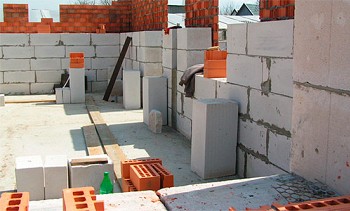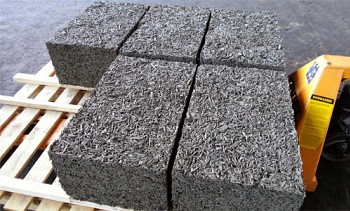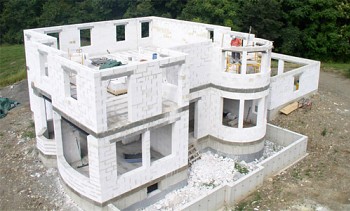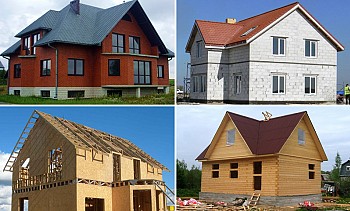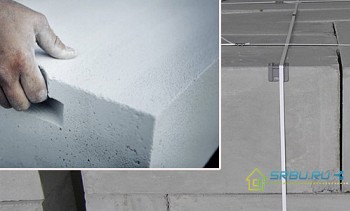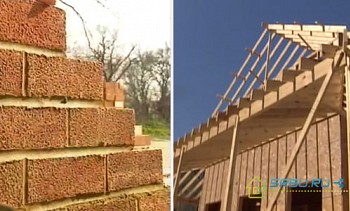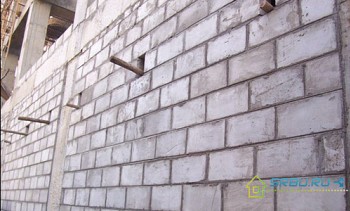Aerated concrete blocks, the disadvantages and characteristics of which we will consider in this article, are becoming more and more popular every year. Many developers choose it as a wall material for their future home.
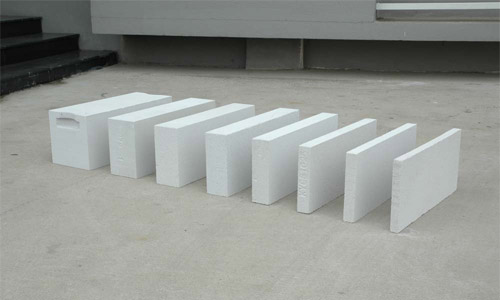
Content:
Aerated concrete blocks, like all building materials, have their advantages and disadvantages. In order not to regret later, it is necessary to familiarize yourself with them in advance. Indeed, load-bearing structures of buildings will be built from aerated concrete, the strength of which will become the basis of their own home.
The declared properties and characteristics of aerated concrete blocks
Aerated concrete is an autoclaved cellular block. The raw materials for their manufacture are quartz sand, lime, cement, water, aluminum powder. All components are mixed and sent to an autoclave, where they foaming under pressure (when highly dispersed aluminum reacts with an alkaline solution) and a porous structure forms.
Classification of aerated concrete blocks, by brands, depending on density:
- - D300-D500 - insulating aerated concrete;
- - D500-D900 - structural and heat-insulating aerated concrete;
- - D1000 – D1200 - structural aerated concrete.
Aerated concrete strength
Despite its lightness, the material has the highest possible strength. Aerated concrete is the perfect compromise between strength, lightness and optimal thermal insulation. Depending on the brand of aerated concrete (300-600), its compressive strength ranges from 1.5 to 3.5 kgf / cm2.
Easy handling of aerated concrete blocks
Easy handling of aerated concrete is an undeniable advantage. It is easily cut and sawn with simple hand tools, resulting in blocks of standard and non-standard sizes and shapes. In the dry state, the coefficient of thermal conductivity of aerated concrete is 0.12 W / m ° C.
Thermal insulation properties of aerated concrete
Aerated concrete blocks brand D600 and D500 - are structural and heat-insulating material with low thermal conductivity. This allows the walls to provide reliable thermal protection in the winter. In summer, a building made of aerated concrete blocks does not overheat. It maintains the optimum temperature for living.
Soundproofing properties of aerated concrete
The ability of aerated concrete blocks to damp sounds depends on the brand, the density of the aerated concrete solution, the thickness of the walls and, to some extent, the technology of their laying.
Fireproof aerated concrete
Aerated concrete blocks are non-combustible material of the highest class of fire resistance. Houses whose enclosing and supporting structures are built of aerated concrete belong to the highest (I and II) degrees of fire safety.
Eco-friendly aerated concrete
The measurement of the radioactivity of building materials is carried out using a qualification coefficient that does not have units and is determined by laboratory means. The radioactivity of aerated concrete blocks is significantly lower than all permissible norms. During operation, aerated concrete does not form toxic components. By environmental characteristics, it is not inferior to natural materials.
Lightweight aerated concrete
The mass of the standard block of aerated concrete measuring 625x100x250 mm. is 8 kg. at an average density of 500 kg / m3 This can significantly reduce mortar consumption and reduce construction time.
Resistance of aerated concrete to biological effects
Aerated concrete blocks are an unfavorable environment for the development of mold, fungi and bacteria that do not appear in it even at a temperature of 30 ° C and air humidity of 98%.According to these indicators, aerated concrete is superior to wood and does not require treatment with antiseptics.

On the shortcomings of aerated concrete blocks
- 1. Due to its low compressive strength and low bending resistance, aerated concrete is a brittle material. The strength of aerated concrete walls directly depends on the correct foundation. A foundation should be built that gives minimal shrinkage. Otherwise, the gas blocks will begin to crack within a couple of years after construction. Recommended tape monolithic foundation and reinforcement of masonry blocks, mesh every 2-3 rows.
- 2. High water absorption of aerated concrete is an obstacle to the implementation of high-quality finishing work. There are frequent cases when a layer of plaster applied to an aerated concrete wall is not kept on its surface. To reduce the water absorption of aerated concrete walls, they are treated with deeply penetrating primers.
- 3. Gas blocks are a weak basis for fasteners. Securing massive objects in aerated concrete walls is rather problematic. Plastic butterfly dowels do not always come to the rescue, in contrast to self-tapping screws, which twist well and hold perfectly in the walls. But there is a danger of their oxidation, after which they can rust and become unusable. Although there are some fasteners that hold pretty well.
Video: Fasteners for gas silicate blocks
- 4. The declared frost resistance of aerated concrete is an advertising trick. The optimum density of the used structural heat-insulating materials is considered to be the density of the D500 grade. Its frost resistance does not exceed 25 cycles. Although the facade requires 50 cycles. Aerated concrete sellers clearly overestimate the frost resistance parameters that are inherent in products with a higher density.
- 5. Aerated concrete has fairly high free lime rates, which contributes to the activation of the corrosion processes of metal inclusions: reinforcement, pipeline, frame, lintels.
- 6. The low cost of aerated concrete blocks declared by manufacturers, taking into account the guaranteed durability of the material, is somewhat exaggerated.
- 7. The durability of aerated concrete is doubtful due to the fact that mass development of gas silicate blocks began relatively recently, and forecasts of their fundamentality have not been confirmed.
The main disadvantages of aerated concrete blocks are listed. In addition to them, there are a number of shortcomings that are more likely associated with violations of the technology of laying aerated concrete blocks and with the desire to sell more expensive material to developers. A detailed examination of such shortcomings often proves their baselessness.
To build a house with your own hands, you can use completely different materials: brick, wood, aerated concrete, etc. All of them have their pros, cons and can be successfully applied in certain conditions.
Video: How to choose gas silicate blocks

